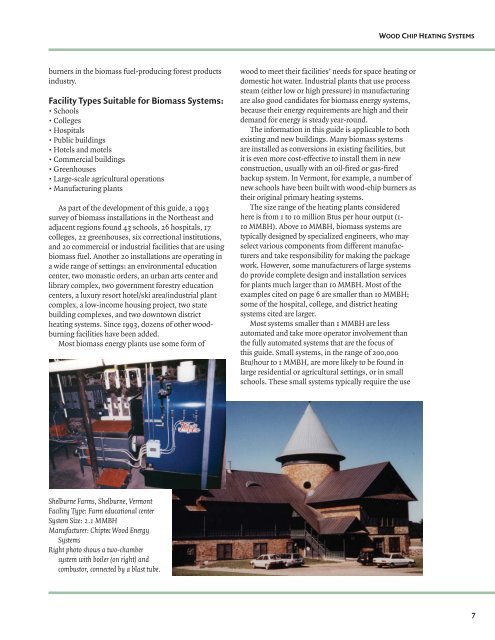Wood-Chip Heating Systems - Biomass Energy Resource Center
Wood-Chip Heating Systems - Biomass Energy Resource Center
Wood-Chip Heating Systems - Biomass Energy Resource Center
Create successful ePaper yourself
Turn your PDF publications into a flip-book with our unique Google optimized e-Paper software.
urners in the biomass fuel-producing forest products<br />
industry.<br />
Facility Types Suitable for <strong>Biomass</strong> <strong>Systems</strong>:<br />
• Schools<br />
• Colleges<br />
• Hospitals<br />
• Public buildings<br />
• Hotels and motels<br />
• Commercial buildings<br />
• Greenhouses<br />
• Large-scale agricultural operations<br />
• Manufacturing plants<br />
As part of the development of this guide, a 1993<br />
survey of biomass installations in the Northeast and<br />
adjacent regions found 43 schools, 26 hospitals, 17<br />
colleges, 22 greenhouses, six correctional institutions,<br />
and 20 commercial or industrial facilities that are using<br />
biomass fuel. Another 20 installations are operating in<br />
a wide range of settings: an environmental education<br />
center, two monastic orders, an urban arts center and<br />
library complex, two government forestry education<br />
centers, a luxury resort hotel/ski area/industrial plant<br />
complex, a low-income housing project, two state<br />
building complexes, and two downtown district<br />
heating systems. Since 1993, dozens of other woodburning<br />
facilities have been added.<br />
Most biomass energy plants use some form of<br />
Shelburne Farms, Shelburne, Vermont<br />
Facility Type: Farm educational center<br />
System Size: 2.1 MMBH<br />
Manufacturer: <strong>Chip</strong>tec <strong>Wood</strong> <strong>Energy</strong><br />
<strong>Systems</strong><br />
Right photo shows a two-chamber<br />
system with boil er (on right) and<br />
combustor, connected by a blast tube.<br />
wood to meet their facilities’ needs for space heating or<br />
domestic hot water. Industrial plants that use process<br />
steam (either low or high pressure) in manufacturing<br />
are also good candidates for biomass energy systems,<br />
because their energy requirements are high and their<br />
demand for energy is steady year-round.<br />
The information in this guide is applicable to both<br />
existing and new buildings. Many biomass systems<br />
are installed as conversions in existing facilities, but<br />
it is even more cost-effective to install them in new<br />
construction, usually with an oil-fi red or gas-fi red<br />
backup system. In Vermont, for example, a number of<br />
new schools have been built with wood-chip burners as<br />
their original primary heating systems.<br />
The size range of the heating plants considered<br />
here is from 1 to 10 million Btus per hour output (1-<br />
10 MMBH). Above 10 MMBH, biomass systems are<br />
typically designed by specialized engineers, who may<br />
select various components from different manufacturers<br />
and take responsibility for making the package<br />
work. However, some manufacturers of large systems<br />
do provide complete design and installation services<br />
for plants much larger than 10 MMBH. Most of the<br />
examples cited on page 6 are smaller than 10 MMBH;<br />
some of the hospital, college, and district heating<br />
systems cited are larger.<br />
Most systems smaller than 1 MMBH are less<br />
automated and take more operator involvement than<br />
the fully automated systems that are the focus of<br />
this guide. Small systems, in the range of 200,000<br />
Btu/hour to 1 MMBH, are more likely to be found in<br />
large residential or agricultural settings, or in small<br />
schools. These small systems typically require the use<br />
WOOD CHIP HEATING SYSTEMS<br />
7





